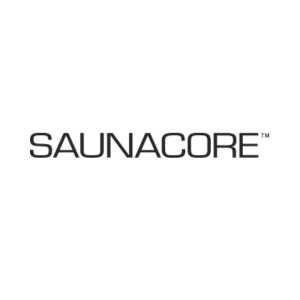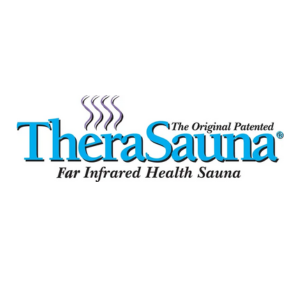Comparing The Benefits And Differences Of
Dry Sauna Vs Wet Sauna
What comes to mind when you think of a sauna? More likely than not, it'll be a picture of a traditional Finnish log cabin-style sauna. Did you know that the two main sauna types offer distinct experiences and benefits?
One is the traditional Finnish-style dry sauna you're probably familiar with, and the other is a steam room, or a wet sauna. Both operate at different temperatures, maintain a specific humidity level, and create a unique atmosphere to offer a customized sauna experience.
The question is, which is the right option for you? How do you decide? In this article, we'll explore the key differences between these two popular sauna styles, health benefits, and the ideal way to enjoy each.
Wet Saunas: What Is It and How Does It Work?
A wet sauna, popularly known as a steam room, uses moist heat to create a warm and humid environment. The primary characteristic of a wet sauna is its high humidity level, which can climb up to a whopping 100%.
Steam saunas typically generate steam through a steam generator (like the MR. Steam MS-E Series) or you pour water over heated rocks. The steam generator heats water to its boiling point, producing steam that gradually fills the room.
When it comes to traditional wet saunas, water is poured over hot rocks, which are heated by a stove or an electric heater. As the water evaporates, it creates steam, increasing the humidity level inside the sauna.
The walls and ceiling of a wet sauna are typically made of materials that can withstand humidity levels, such as tile, glass, or acrylic. The room is also designed to be airtight to maintain the optimal humidity level.
Wet saunas operate at much lower temperatures than dry saunas, usually between 90 and 120 degrees Fahrenheit. The air may feel thick and heavy when you enter a wet sauna, but since the temperature is lower than in a dry sauna, you won't feel overly hot or uncomfortable.
This makes it suitable for people at increased risk of heat-related illnesses, including those over 60 years, or people suffering from cardiovascular disease, pulmonary disease, or long-standing diabetes.
Steam saunas offer several benefits, including:
-
Reduced systemic inflammation
-
Improved circulation
-
Increased lung capacity
-
Cleared congestion
-
Improved cardiovascular health
-
Better skin health
-
Enhanced workout recovery
-
Reduced stress
Dry Saunas: What Is It and How Does It Work?
Originating in Northern Europe around 2000 BC, a dry sauna is one of the oldest wellness practices that remain a mainstream health trend. A dry sauna (such as the Almost Heaven Rainelle) is a cozy, wooden room designed to increase your body temperature and make you sweat to improve your detoxification process.
The dry sauna works its magic by using an electric, wood, or gas-powered heater. The heater warms up the sauna room to a high temperature, ranging from a toasty 160 to a sweltering 195 degrees Fahrenheit.
As the room heats up, the air inside becomes hot and dry, with a relative humidity of around 10% to 20%. This low humidity level distinguishes a dry sauna from other saunas, including steam saunas.
Let's not forget about the löyly. In a Korean dry sauna or Finnish tradition, users pour water over the hot rocks of the sauna stove, creating a burst of steam that raises the humidity for a brief, exhilarating moment.
Wondering what a dry sauna does? Studies have shown that your core body temperature increases in a heated environment, triggering your sweat glands to produce sweat for thermoregulation.
Research shows that the high dry sauna temperature improves skin elasticity while reducing the appearance of acne scars and stretch marks.
A dry sauna also does wonders for muscle recovery. The heat in a dry sauna causes blood vessels to dilate, increasing blood flow and improving circulation. Studies show that this increased circulation helps deliver oxygen and nutrients to the body's tissues, promoting healing and speeding up recovery.
Besides that, dry saunas offer a range of health advantages, including:
-
Relieves stress and anxiety
-
Boosts metabolism
-
Increased flexibility and joint mobility
-
Aids in detoxification
-
Improved sleep quality
-
Provides mental clarity and improve focus
Dry Saunas vs. Wet Saunas: What's the Difference?
If you're still wondering about the difference between a sauna and a steam room, here there's a quick look at their key differences.
Method of Heating
The heating method is one of the most significant differences between wet and dry saunas. Dry saunas use wood-burning stoves or electric heaters to heat the air inside the sauna. This creates a warm and cozy environment that encourages sweating and relaxation.
Wet saunas (otherwise known as steam rooms or steam baths) create a humid environment by using a steam generator to heat water and release steam into the room. This results in a moist, steamy atmosphere that can feel like stepping into a tropical rainforest or a cloud of warm mist.
Temperature and Humidity
Regarding temperature and humidity, dry and wet saunas are vastly different. Dry saunas typically have a higher temperature, ranging from 160 to 195 degrees Fahrenheit, but with lower humidity levels (usually around 10-20%).
Wet saunas have lower temperatures, around 90 to 120 degrees Fahrenheit, but with much higher humidity levels, often reaching 100%. This moist environment can work wonders for hydrating your skin and soothing the respiratory system.
It's important to note that the moist environment can also be a breeding ground for bacteria and mold, so make sure you maintain proper hygiene.
Additionally, if you have an open wound or a compromised immune system, take extra care when using wet saunas. The high moisture content can potentially exacerbate existing infections or skin conditions.
Health Benefits
While both dry and wet saunas offer several health benefits, they also have some unique advantages. Dry saunas are popular for their detoxifying effects. Their dry heat can help encourage sweating, flushing toxins from your body. Dry saunas also promote better sleep and increased endurance, making them popular among athletes and fitness enthusiasts.
Wet saunas, on the other hand, can do wonders for respiratory health. Steam rooms have several benefits for respiration, from helping clear congestion and improving breathing to providing relief for folks with asthma or allergies. Plus, the moist heat is excellent for hydrating your skin and opening pores to help you eliminate all the gunk and dirt, giving you that perfect post-sauna glow.
Personal Preference
Ultimately, it all comes down to what you want. Some people prefer the dry heat of a traditional sauna, which is much more intense and invigorating. Others enjoy a wet sauna's moist, steamy environment primarily due to its soothing and gentle feel on the skin and respiration.
Dry Sauna vs. Wet Sauna: Which Is Better for You?
When choosing between a dry sauna and a wet sauna, the answer ultimately depends on your preferences, needs, and wellness goals.
If you're seeking an authentic sauna experience, dry saunas are the way to go. The dry heat provides a soothing environment that helps ease stress, relieve tension, and promote overall mental well-being.
Similarly, incorporating dry sauna sessions into your workout routine can benefit those planning to shed those extra pounds. Research also suggests that dry sauna sessions can help boost your metabolism. This may help to burn more calories.
Dry saunas have also been shown to improve cardiovascular health, making them an ideal choice for folks looking to enhance their heart's well-being. UCLA Health explains that regular dry sauna sessions can help lower blood pressure, enhance circulation, and reduce the risk of heart-related diseases.
If you have dull, dry skin, a wet sauna session may be just what you need. The soothing warmth dilates blood vessels, increasing blood flow throughout the body. Cleveland Clinic claims that this enhanced blood circulation leads to better oxygen delivery to your skin, promoting a healthy and radiant complexion.
If you dread consuming detox drinks and cleanse juices, a wet sauna offers a more enjoyable alternative. The high humidity in a wet sauna encourages sweating, which is essential for detoxifying the body. As you sweat, your pores open up, releasing toxins and impurities.
Similarly, if you're struggling with a stuffy nose, battling seasonal allergies, or dealing with other respiratory issues, a wet sauna may provide some much-needed relief.
Medical News Today explains that the warm, moist heat can help soothe irritated nasal passages and loosen up phlegm, reducing congestion and promoting easier breathing. This can be especially beneficial for people suffering from chronic bronchitis, asthma, and other pulmonary diseases.
Whichever type of sauna you choose, remember to stay hydrated, listen to your body, and cut your session short if you experience discomfort.


Tips for Choosing a Sauna
When buying a sauna, regardless of whether it's dry or wet, you need to consider a couple of factors.
Here are some tips to help you find the right sauna for you:
-
Consider your available space. You will need to measure the area where you want to install the sauna and ensure it has enough clearance for ventilation, access, and safety.
-
Research different models and brands. Compare different sauna options, features, prices, reviews, and warranties. Look for reputable manufacturers that offer quality materials, craftsmanship, and customer service.
-
Look into energy efficiency ratings. Check how much electricity or gas the sauna will consume and how much it will cost. Choose a sauna that has a low environmental impact and a high performance.
-
Consider your budget. Saunas can easily range from a few hundred to several thousand dollars depending on the size, type, design, and accessories you choose. Set a realistic budget and stick to it. Look for discounts, deals, and financing options if available.
-
Check the warranty coverage. Ensure the sauna has a comprehensive warranty covering parts, labor, and service for a reasonable period. Make sure you read the fine print and understand what the warranty covers.
-
Think about the number of people who will use the sauna. If you plan to enjoy the sauna with your family or friends, you will need a larger sauna with enough bench space for everyone. If you prefer to use the sauna alone or with one other person, you can opt for a smaller sauna that is more cozy and intimate.
-
Determine how often you plan to use the sauna. If you are a regular sauna user, you will want a durable and reliable sauna that can withstand frequent use. Conversely, you may not need a high-end sauna with all the bells and whistles if you are an occasional sauna user.
-
Choose a location for your sauna. You can install your sauna indoors or outdoors depending on your preference and availability of space. Indoor saunas are more convenient and protected from the elements, but they may require more ventilation and plumbing work. On the other hand, outdoor saunas are more natural and scenic, but they may need more maintenance.
FAQs
Is a Dry Sauna Better Than a Steam Sauna?
Whether a dry sauna is better than a steam sauna ultimately depends on individual needs and personal comfort. A dry sauna is the way to go if you want a more intense, health-boosting experience.
If you prefer a more relaxed and soothing environment where you can unwind after a long day at work or school, steam saunas are the way forward.
Is It Okay To Use The Sauna Daily?
Yes, it's okay to use a daily, as long as you follow proper sauna etiquette and pay attention to your body's signals. It is essential to stay hydrated, limit session times to 15 to 20 minutes, and avoid alcohol or heavy meals before entering the sauna.
Regardless of the type of sauna you use, individuals with certain medical conditions, such as heart problems or high blood pressure, should consult their healthcare provider before incorporating sauna bathing into their routine.
Pregnant women and those taking prescription medications that can affect body temperature should also exercise caution.
Are Infrared Saunas a Good Option?
Generally, infrared saunas, such as TheraSauna Classic, are an ideal choice for anyone who wants to reap maximum benefits from sauna therapy.
Equipped with infrared panels that emit far-infrared wavelengths, the heat from such saunas penetrates the skin more deeply, providing a more efficient and targeted heat therapy.
This deep heat penetration can help improve detoxification, muscle recovery, and pain relief. Since infrared saunas don't need heating rocks to create steam, they're a lot more energy-efficient and much easier to maintain.
Dry Sauna Safety and Precautions
Dry saunas can also negatively affect your health if you use them improperly or excessively. Here are some of the risks and precautions that you should consider before you enter a dry sauna:
-
Dehydration: Dry sauna can cause you to lose a lot of water and electrolytes through sweating. This can lead to dehydration, which can cause headaches, dizziness, nausea, fatigue, and cramps. To help avoid this, drink plenty of water before, during, and after your sauna session. You should also avoid alcohol, caffeine, and other diuretics that can dehydrate you further.
-
Overheating: Dry sauna can raise your body temperature to dangerous levels if you stay in too long or the room is too hot. This can lead to heat exhaustion or heat stroke, which can cause confusion or fainting. Limit your sauna session to 15 to 20 minutes or less, depending on your tolerance level. You should also monitor how you feel and leave the sauna if you feel unwell or uncomfortable.
-
Alcohol consumption: Dry sauna can increase the effects of alcohol on your body and brain, impairing your judgment, coordination, and reaction time. It can also increase your risk of dehydration, overheating, and low blood pressure. Consider avoiding alcohol before or during your sauna session. You should also wait at least an hour after your sauna session before drinking alcohol.
Tips for the Perfect Sweat Session
Dry saunas can be a wonderful experience if you follow some simple tips and guidelines. Here are some of them:
-
Wear the right clothes: Opt for loose and comfortable clothing or a towel when you use a dry sauna. Make sure you remove any jewelry, glasses, contact lenses, or other accessories that can heat up or irritate your skin. You should also consider bringing a towel to sit on and another one to wipe your sweat.
-
Prepare yourself: You should shower before entering a dry sauna to remove any dirt, oil, or cosmetics from your skin. This will help you sweat more easily and prevent any potential infections or irritations. Ensure you load up on water before your sauna session to prevent dehydration.
-
Enjoy yourself: Make sure to relax and simply enjoy your time in the dry sauna. You can listen to music, read a book, meditate, or chat with your friends. Breathing deeply can help oxygenate your blood and calm your mind.
-
Cool down gradually: Consider leaving the dry sauna when you feel hot enough or when your time is up. You should not stay longer than 20 minutes or more than once a day. Try to cool down gradually by taking a shower, drinking water, or resting in a cool area. This will help you avoid sudden changes in your body temperature and blood pressure.
Dry Sauna Experience: FAQs
How Long Should You Sit in a Dry Sauna?
How long you should sit in a dry sauna depends on your preference and needs. Ideally, you should start with shorter sessions in a dry sauna, around 5 to 10 minutes, and work your way up from there. Ensure not to exceed 20 minutes in a dry sauna without taking a break to avoid excessive dehydration or hyperthermia.
Is a Dry Sauna Really Good for You?
Absolutely! Research suggests regular dry sauna sessions can help improve cardiovascular health, ease muscle pain, increase metabolic rate, and even reduce stress.
Is It Okay To Use a Dry Sauna Every Day?
Yes, using a dry sauna daily is safe if you take proper precautions and don't extend your session beyond 20 minutes. If you take any medications or have any medical conditions, such as heart disease, high blood pressure, or diabetes, consult your healthcare provider before planning a sweat session.
What Should I Do Before a Dry Sauna?
You can do a couple of things before a dry sauna to maximize your experience. For starters, make sure you're well-hydrated. Water, herbal tea, or refreshing coconut water are all good options.
You can also eat some light snacks to keep your energy levels up, but avoid anything too heavy or fatty, to avoid any potential nausea.
Always remove your jewelry and wristwatch, as the heat or sweat can potentially damage them. You may also want to take off your shoes and wear flip-flops or sandals because the floor can get very hot and slippery. If you sit on a bench or chair in the sauna, consider bringing a towel to sit or lay on.
Do I Have To Shower Before a Dry Sauna?
While you aren’t required to shower beforehand, it's generally a good idea. Showering before a dry sauna session can help remove sweat, oils, and residual makeup from your skin, so you can sweat freely without potentially clogging your pores.
Do You Wear Clothes in a Dry Sauna?
Wearing clothes in a dry sauna is a matter of personal preference and cultural norms. While most people use the sauna nude or with a towel wrapped around them, others may feel uncomfortable being naked in front of others.
If you choose to cover yourself, opt for loose-fitting breathable garments made of cotton or linen. Avoid wearing synthetic fabrics like nylon or polyester, as they stick to your skin and cause irritation.
Some saunas may have specific dress codes or policies to follow. Always check with the staff or the sauna website before you go, and respect the norms of other users.

Dry Sauna vs. Wet Sauna: Final Thought
When it comes to dry and wet saunas, the difference is pretty obvious. One is hot and steamy, while the other is simply hot.
While both offer unique experiences and benefits, the choice ultimately comes down to your desire. It's essential to consider factors such as health conditions, desired benefits, and overall comfort when choosing between a dry vs. wet sauna.
If you would rather not use the shared sauna at your gym and are looking for an at-home sauna, check out MySaunaWorld's collection of traditional and infrared saunas. For more information or queries, feel free to contact us, and our friendly staff will gladly assist you.
SIGN UP. SAVE BIG.
Subscribe to be the first to know about our special monthly sauna sales, sent right to your inbox.

About the Author
Adam Fromson
Adam Fromson, co-founder of My Sauna World, loves saunas and their transformative health benefits. With years of experience exploring sauna culture and its impact on health and wellness, Adam is passionate about helping others discover the life-changing benefits of saunas for themselves.
Let customers speak for us
from 385 reviews
Good communication, easy delivery, easy set up, easy operation, great value. Recommended!
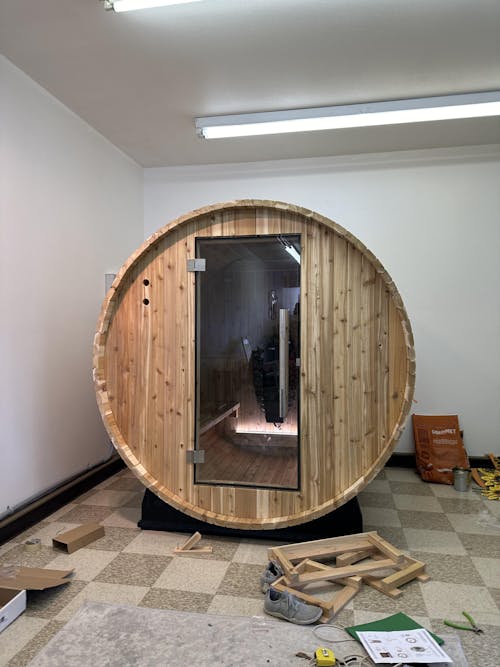
We ordered the 4 person barrel sauna and love it! We wanted a little extra space for the 2 of us/guests and it’s great. We could definitely fit 4 people in it if we needed. We use it every single day. It took about 10 weeks to get here because they build it specifically for the order. Putting the barrel together was fairly easy with 2 people. The electrical and the heater definitely required an electrician to install as we could have not done it alone.
We ordered the biggest heater (harvia spirit 8kw) and it heats up the sauna in about 15 mins inside our 40-50° garage. Overall this style of sauna is hotter and you sweat a lot faster than in an infrared sauna. I truly 10/10 recommend!
Pic is of us in the middle of building it.
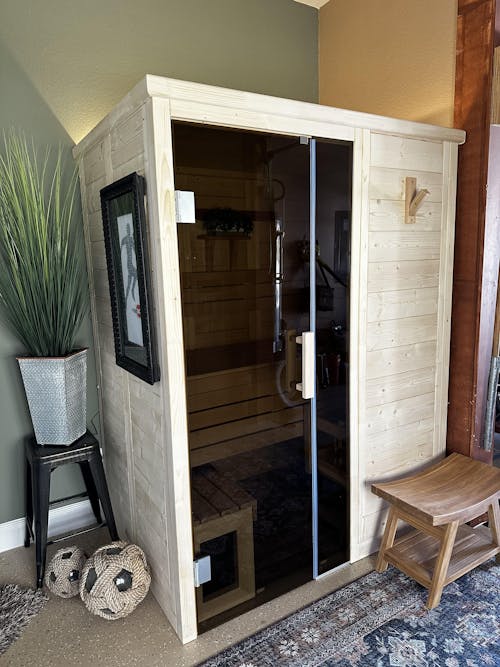
Took me about 6 hours over 2 evenings to assemble almost all by myself. Had a pro run a new circuit from my panel. Very well made and assembly was straightforward. Heater is well sized and reaches operating temperature in under 30 minutes.

Great sauna very easy to assemble

The salt panel was a great addition to our Madison Sauna. It has excellent grain which is accented by the amazing color lights that glow through the panel. Also when you hit the rocks with a splash of water you can feel the heat bounce off the panel. Great addition if you are considering this option.
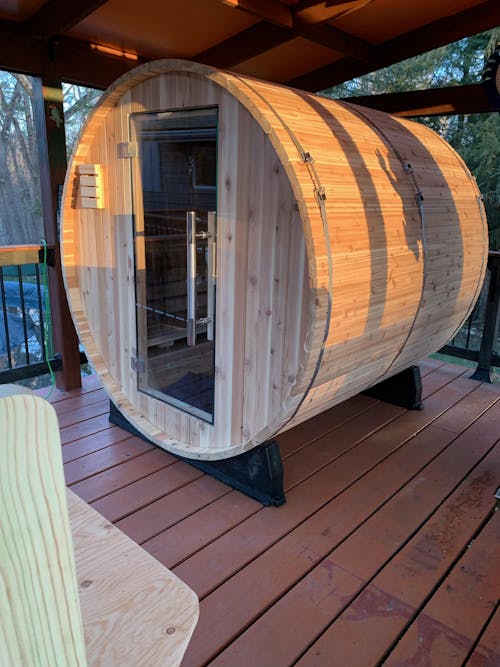
We can say enough about Sauna World there customer support is great! Our Pinnacle Sauna from Almost Heaven is epic.
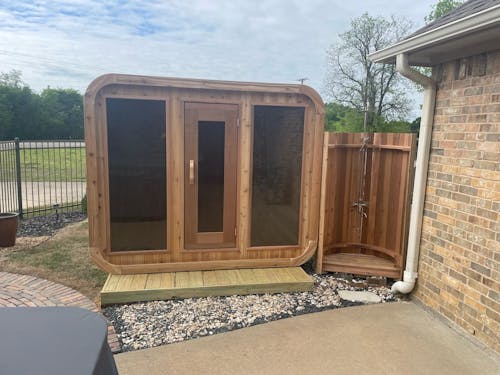
The finish and quality is outstanding and it was quick and easy to assemble.

We are thrilled with our mini pod!! It came well shipped and our friend assembled it in 11 hours! Wow! We cannot wait to get healthy and sauna it up!

Beautiful sauna!!! Much easier than I expected to assemble, took a total of 4 hours. Can't wait to get warm by the pool on those cool evenings. Customer service was excellent..

Purchased a 2 person Almost Heaven barrel sauna and were delighted with the product. The order process was quick and easy, the sauna arrived on-time, installation was simple, following the provided instructions, and the sauna is extremely high quality. We’ve used it daily for over 2 weeks and quite frankly I don’t know how we lived without it. If I had it to do over again I wouldn’t change a thing... except maybe purchasing a 4 person model to easier share with friends!

Great Customer Service and a breeze to put together.Excellent shipping and the Sauna is top notch, couldn’t be happier























